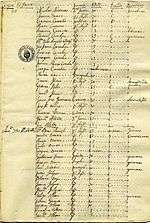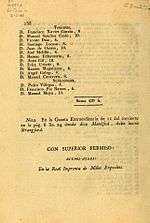Manuel Canaveris
| Manuel Canaveris | |
|---|---|
| Birth name | Manuel José Ramón Cornelio Jugluns de Canaveris |
| Born |
1787 Buenos Aires, Viceroyalty of Rio de la Plata |
| Died |
1830 Buenos Aires, Argentina |
| Allegiance |
|
| Years of service | 1806-1812 |
| Rank | Lieutenant |
| Unit |
Tercio de Cántabros Montañeses Regimiento de Patricios |
| Battles/wars |
British invasions of the Río de la Plata May Revolution War of Independence |
Manuel Canaveris (1787–1830) was an Argentine army officer, Lieutenant in the Regiment of Patricians. He also served as Lt. in the 4th Regiment of Buenos Aires.[1] Canaveris and his family had a active participation during the English invasions and May Revolution. His father was one of the neighbors who attended the Open Cabildo of May 22, 1810.[2]
Personal life

Manuel was born on September 15, 1787 in Buenos Aires, the eighth son of Juan de Canaveris and Bernarda Esparza. Her family consisted of six brothers and six women, born between 1773 and 1797. They lived in the house of his maternal grandmother María Eugenia Sánchez,[3] (1730-1817, buried in Santo Domingo), located in the San Miguel street, (now Bartolomé Mitre) between 25 de Mayo and Leandro N. Alem, in the neighborhood of San Nicolás.[4]
Manuel Canaveris, married at parish church Nuestra Señora de Montserrat on April 24, 1811, with María Angeles Rodríguez, daughter of Basilio Rodriguez and Anselma Calderón, descendant of Pedro Rodriguez Flores. They had eight children, Sinforoso, Antonino, María Juana, Eustaquia, Serapio, Rufino, Vicente and Ruperta Canaveri.[5]
Their daughter, Juana María Canaveris y Rodríguez Calderón married Juan de Michelena del Pino (military),[6] son of the Captain Juan Ángel Michelena, born in the city of Maracaibo and supporter of the realist forces, during the wars for independence.[7] Juan Michelena husband of Juana Canaveris, was maternal grandson of Joaquín del Pino and nephew in-law of Bernardino Rivadavia.[8] Juana Canaveris de Milchelena belonged to Sociedad de Beneficencia Familiares de La Guardia Nacional (Charity Society of the National Guard), chaired by Victoria Pueyrredon de Lynch.[9]
His eldest son Sinforoso Camilo Canaveris (1808-1872) married Manuela Pelliza, daughter of Francisco Pelliza. After his first wife died, Sinforoso C. Canaveris is dedicated to trade, owned a Grocery store on Victoria Street, located one block from the Plaza de la Victoria.[10] S. Camilo Canaveris marry for the third time in 1852, with Quintina Páez, born in Montevideo, descendant of Melchor Colman and Margarita Burgues Carrasco, a traditional Uruguayan family, remote descendants of Nicolás Colman and Vasco Fernandes Coutinho.[11]
Military career


Like other members of his mother's family, Manuel Canaveris served in the military. His mother's ancestors include Captains Miguel Gerónimo Esparza,[12] Francisco de Salas Reynoso, Pedro Morales y Mercado and Gonzalo Carbajal,[13] General and Lieutenant Governor of Santa Fe.[14]
Manuel Canaveris and his brothers Mariano, Joaquín and José were members of the volunteer militias, for defense of Buenos Aires during the British invasions of the Río de la Plata 1806-1807. In the second British invasion Manuel Canaveris, had served in the Cántabros Montañeses, Mariano Canaveris served in Húsares de Pueyrredón, José Canaveris in the Quinteros y Labradores,[15] and Joaquín Canaveris in the Tercio de Vizcaínos, formed by volunteers of Basque origin.[16]
Between 1809 and 1810, Canaveris was Sub-lieutenant Abanderado in the 4th Regiment of Infantry, formed by members of the "Tercio de Cántabros Montañeses". The Cántabros regiment was one of the units held by Viceroy Liniers, during Mutiny of Álzaga.[17] Canaveris served in the same regiment during the events of May 1810, participating in the early years of the struggle for independence in Argentina.
In 1810 Canaveris was promoted to Lieutenant of the 4th Regiment, under the orders of the Colonels José Merelo and Ignacio Álvarez Thomas. He together with the officers of the regiment, had contributed money for the First Upper Peru campaign.[18]
In 1812 after the Motín de las Trenzas, Canaveris was appointed as Lieutenant in the Regiment of Patricians, commissioned officer of the 7° Compañia de fusileros, (Fusilier Company), serving in the guarnición of Buenos Aires.[19] The Patricians began using Brown Bess muskets, (known as "tower") which had been seized from the British invaders.[20]
Manuel Canaveris was retired from the Army at the age of 24 years, on January 17, 1812.[21] After his retirement from the militia, was dedicated to his farm had a small ranch in the village of Barracas.
Descendants
Manuel Canaveris was the ancestor of the commanders- Francisco Canaveri (1827-1860s, Lieutenant of the cavalry),[22] Saturnino Canaveri (Lieutenant colonel), who had participated in military expeditions against the Indians during the Conquest of the Desert.[23] And the Lieutenant colonel Isabelino Canaveris, (born in Montevideo), had been involved in armed conflicts in Uruguay.[24]
His grandson Camilo Alejo Canaveri, godson of José Antonio Durán, served as attorney of Enrique Mathet and José Camilo Crotto (1863-1936), Governor of Buenos Aires between (1918-1921).[25] His other grandson had been Sinforoso Canaveri (1857-1930s, inhabitant of Adrogué) notary of government in the city of La Plata, who had made the contracts of scriptures concerning sale of land by Claudio M Joly (French citizen and co-founder of the town of Moreno) to the Lacroze company, (owned by Federico Lacroze), for the construction of the tramway station and the expansion of the rail network of Buenos Aires Central Railway.[26] Canaveri had also served as notary public in the City Porteña, had his office on the May Avenue in the exclusive neighborhood of Monserrat.[27] He was married to Angélica Andrade, daughter of landowners, and descendant of Casimiro Alegre. And of Francisco Monterroso, (born c.1760 in Puerto de Santa María) the gunsmith to the Regiment Cantabros Montañeses .[28]
Manuel Canaveris was the uncle of Juan Manuel Bayá (Trade Commissioner) and of Sinforoso Amoedo a prestigious doctor of medicine.
References
- ↑ Il lavoro degli italiani nella Republica Argentina, dal 1516 al 1910: studi, leggende e riceche, Emilio Zuccarini
- ↑ Ensayo histórico sobre la revolución de mayo y Mariano Moreno:, El Ateneo, 1949
- ↑ Documentos para la historia argentina, Argentina
- ↑ Genealogía, hombres de mayo, Revista del Instituto Argentino de Ciencias Genealógicas, 1961
- ↑ Genealogía, Números 13-15, Instituto Argentino de Ciencias Genealógicas
- ↑ Memoria, Parte 2, Argentina. Ministerio de Guerra y Marina
- ↑ Nobiliario del antiguo virreynato del Río de la Plata, Carlos Calvo
- ↑ Rivadavia: homenaje en el centenario de su muerte, Asociacioń Bernardino Rivadavia, Bahiá Blanca, Argentine republic
- ↑ Historia de la Población de General San Martín (PDF), Hialmar Gammalsson
- ↑ Impuesto de patentes: Rejistro de los contribuyentes de la ciudad de Buenos Aires, Buenos Aires (Argentina). Dirección de Rentas
- ↑ Génesis de la familia uruguaya:, Juan Alejandro Apolant
- ↑ Acuerdos del extinguido Cabildo de Buenos Aires, Buenos Aires (Argentina). Cabildo; Biedma, José Juan
- ↑ Genealogía, Issue 13, Instituto Argentino de Ciencias Genealógicas 1961
- ↑ Historia de la Provincia del Chaco: Los fundadores, Carlos P. López Piacentini
- ↑ Invasiones inglesas al Río de la Plata 1806-1807, Marcos de Estrada
- ↑ Los Tercios Españoles en la Defensa de Buenos Aires (1807) (PDF), Horacio Guillermo Vázquez Rivarola
- ↑ Historia de la República Argentina: su origen, su revolución y su desarrollo político hasta 1852, Volumen 1, Vicente Fidel López
- ↑ Documentos Para La Historia Del General Don Manuel Belgrano, Instituto Belgraniano Central (Buenos Aires, Argentina)
- ↑ Tomas de razón de despachos militares, cédulas de premio 1740 a 1821, Archivo General de la Nación (Argentina)
- ↑ Boletín del Centro naval, Número 709, Argentina. Ministerio de Marina
- ↑ Registro nacional de la República argentina, Talleres gráficos de la penitenciaría nacional, 1879
- ↑ Boletín interno, Issues 51-59; Issues 61-90, Instituto Argentino de Ciencias Genealógicas
- ↑ Argentina-Chile, una frontera caliente, Miguel Ángel Scenna
- ↑ La Revolución Oriental de 1870, Abdon Arozteguy
- ↑ Crotto : historia de una ingratitud, Ernesto Quiroga Micheo, Ernesto Raúl Quiroga Vergara
- ↑ La municipalidad y el ferro-carril de Buenos Aires al Pacífico, Ernesto Quesada
- ↑ Anuario de la América latina(Bailly-Baillière-Riera), Sociedad anónima "Anuarios Bailly-Baillière y Riera reunidos
- ↑ Indice del archivo del gobierno de Buenos Aires: correspondiente al año de 1810, Manuel Ricardo Trelles
External links
- Gazeta de Buenos Aires - archive.org
- Registro nacional 1810/1821 - Digital Library
- familysearch.org
- familysearch.org
- familysearch.org
- familysearch.org
- familysearch.org